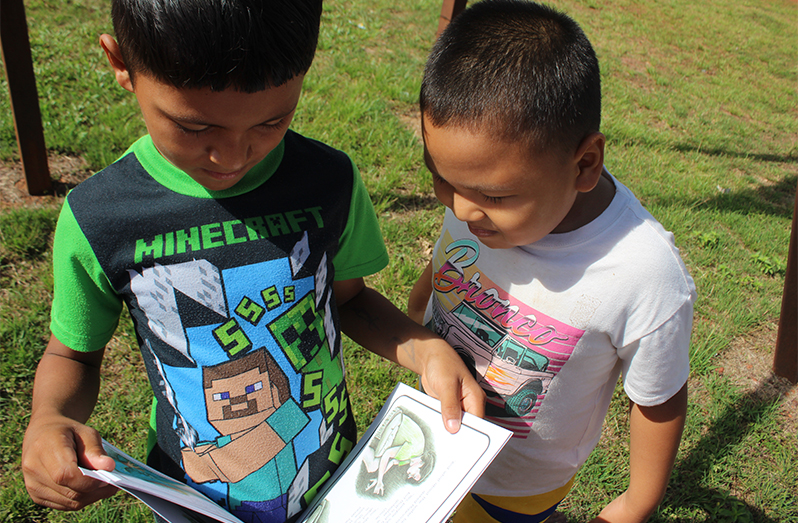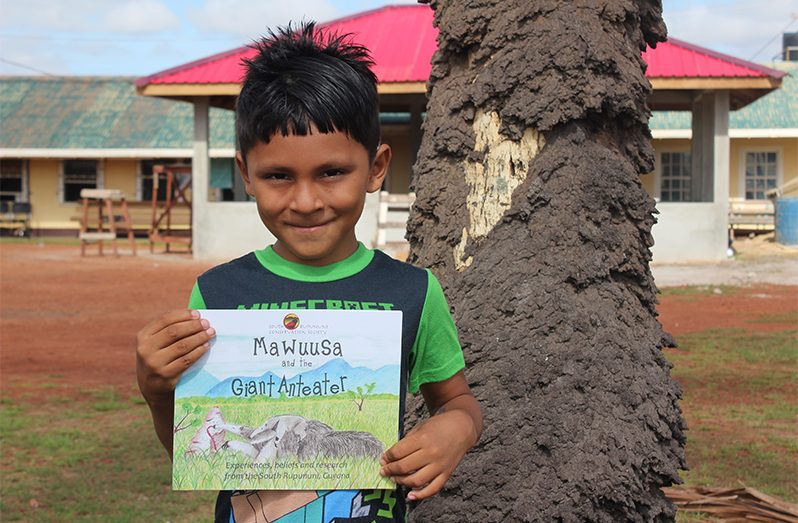– To spread awareness of Giant Anteaters in the Rupununi
“MAWUUSA and the Giant Anteater — Experiences, beliefs and research from the South Rupununi, Guyana” is the title of a new storybook produced by the South Rupununi Conservation Society (SRCS) as a means of presenting researched information on Giant Anteaters in a simple and easy-to-understand format that could be distributed to residents of the Rupununi and the rest of Guyana.
The storybook tells the tale of a young girl from Katoonarib village called Mawuusa who wants to learn more about Giant Anteaters in Guyana. The information in the book combines local stories and beliefs with scientific results and conservation activities that were all collected through the SRCS Giant Anteater research and conservation project in the South Rupununi.
The book contains many beautiful illustrations drawn by local artist Junior Rudolph, born in Masakanari. Its lead author is Erin Earl, who led the Giant Anteater research project and is a member of the IUCN Xenarthran specialist group.

In the coming weeks, the books will be distributed to communities throughout the Rupununi and are intended for children, teenagers, adults and anyone who wants to know more about Giant Anteaters.
New storybook by SRCS combines local stories and scientific results srcs.rupununi@gmail.com,” SRCS Programme Coordinator Neal Millar told Pepperpot Magazine a few days ago.
The research activities and publishing of the book were made possible with the support of the Sustainable Wildlife Management Programme Guyana and the Small Grant Programme Guyana. Soon, Millar said the SRCS hopes to publish storybooks on the other species with which the organisation is working, including the Red Siskin and the Yellow-spotted River Turtle.
Providing some background information on the project, Millar recalled that prior to 2019, there had never been any research conducted on Giant Anteaters in Guyana. Whilst there had been a lot of research conducted in all of the other South American countries where the Giant Anteater could be found, Guyana had no data on the species. As such, it was not known whether the species population was decreasing, increasing or was stable.

The SRCS subsequently conducted two activities. The first of these was a camera- trapping exercise whereby SRCS trained local residents from four Indigenous communities – Katoonarib, Sawariwau, Shulinab and Wariwau — to set camera traps.
The aim of this exercise was to collect information on the population size of Giant Anteaters in each community, their behaviour, their range and more. After a period of three months, the camera traps were collected and the data was analysed.

Based on the images provided by the camera traps, SRCS produced multiple findings, including an estimated population of 37 Giant Anteaters in the community of Katoonarib. The figure was calculated by identifying individual anteaters. This can be done as every Giant Anteater is unique as they all have distinct markings.
Another interesting result from the camera traps was that Giant Anteaters were often seen climbing trees. “This behaviour had never really been observed throughout the rest of South America, so it was very interesting to see it occurring frequently in Guyana,” Millar shared.

The second activity conducted was completing household surveys in the four communities. The rangers were trained to go to households and to ask residents of the communities a series of questions.
All of the results from the activities have been used to develop conservation management activities for the species in the four communities, including the creation of Giant Anteater Community Conservation Zones.












